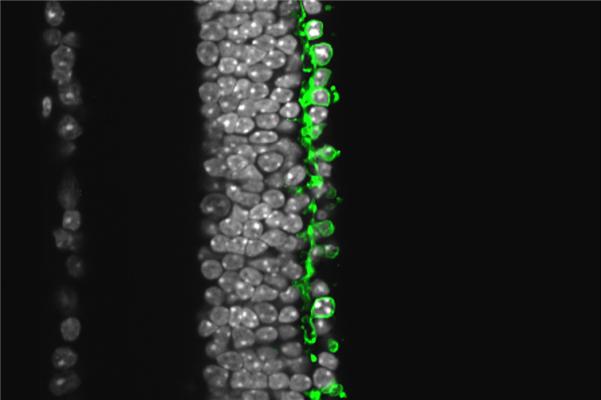Scientists from the Friedrich Miescher Institute for Biomedical Research (FMI)say they have restored vision in retinitis pigmentosa using an archaebacterial protein, halorhodopsin. Introducing light-sensitive halorhodopsin into the remaining but nonfunctional cone photoreceptors of the retina of mice not only reactivates the cone cells’ ability to interact with the rest of the visual system, it also prompts visually guided behavior. With their collaborators in the Vision Institute of Paris, the scientists were able to validate their results in light-insensitive human retinas in vitro, which were able to respond to light again after treatment.
In their work, they were not only able to specifically produce halorhodopsin in the dormant cone cells of mice with retinitis pigmentosa, but they could also show that the cones were able to interact with the rest of the visual system. The existing network of cells was able to reproduce many of the functions of the complicated cascade of molecular events that turn a unit of light into a neuronal signal. What is more, behavioral tests indicated that the retinal information was used for visually guided behavior. The remaining cone cells are therefore an optimal target for gene-therapeutic intervention in disease where photoreceptor function is lost.

Cross section of a degenerated Retinitis pigmentosa retina. The archaebacterial halorhodopsin is produced in the remaining cone photoreceptor cells (green). Only one row of photoreceptor cells is left. In white the nuclear layers of the retina. Credit: FMI
As a first step to translate these findings to patients, together with their collaborators from the Vision Institute of Paris, the FMI group introduced the archaebacterial halorhodopsin into nonfunctional human cone cells. And these treated cones in isolated human retinas started to respond to light.
“We believe that with our gene therapeutic method we have found a powerful approach that could eventually help a subset of retinitis pigmentosa patients. Our colleagues in Paris are screening patients to determine who may benefit most from this approach,” comments Botond Roska.
Citation: Busskamp V, Duebel J, Balya D, Fradot M, Viney JT, Siegert S, Groner AC, Cabuy E, Forster V, Seeliger M, Biel M, Humphries P, Paques M, Mohand-Said S, Trono D, Deisseroth K, Sahel JA, Picaud S, Roska B.(2010) Genetic Reactivation of Cone Photoreceptors Restores Visual Responses in Retinitis Pigmentosa. Science, DOI: 10.1126/science.1190897





Comments